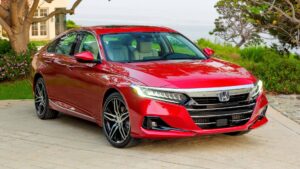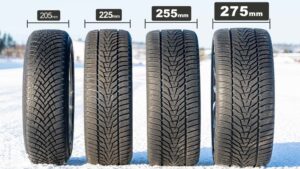In early December Porsche took a highly modified 911 Carrera 4S to the Ojos del Salado volcano in Chile to break the world record for highest altitude driven by a vehicle. The car, driven by three-time Le Mans winner Romain Dumas, had a myriad of rock crawling-specific mods to help it up the mountain. But none were more interesting than its steer-by-wire system, the first to appear in any new Porsche product.
Built in collaboration with German parts supplier Schaeffler, the steer-by-wire system is the most significant upgrade found on Edith, the record-setting 911, versus Doris, the original prototype shown in 2019, which uses an unmodified production steering rack.
Unlike some other steer-by-wire systems, Porsche’s “Space Drive” steering system is totally digital, with no physical connection between the steering wheel and the front wheels. According to Porsche, the steering gear itself is motivated by a servomotor, while the steering wheel is connected to a force feedback module to generate feedback to the driver. Everything is managed via a box of electronics found where the passenger seat would be, and controlled via a panel that sticks out from the right side of the dash.
While most steering systems are developed to translate as much feel and feedback as possible to the driver, Porsche’s Space Drive goes in the opposite direction. It’s designed to remove unwanted forces coming from the front end into the steering wheel in favor of smoothness and stability. As it turns out, the last thing you’d want from a steering wheel is sudden jolts from big rocks while scaling the side of a mountain. That “kickback” is something engineers strived to eliminate both for performance and safety reasons.
“[Dumas] didn’t want to get these big impacts on the steering wheel,” Sven Schaarschmidt, chassis engineer for the car, told Motor1. “He wanted to have a good feeling about what the traction was, but he didn’t want that.”
The Space Drive system also has a large amount of adjustability, says Schaarschmidt.
“You could adjust it if you want to feel more,” he told Motor1. “You can adjust everything as you like. You can change the ratio, you can limit or adjust the steering wheel forces, you can do everything.”
In practice, the steering feels more simulation than reality. It was clear that even after a short test drive through a medium-difficulty off-roading course in Malibu, this system was developed for a singular objective, and that objective was not traditional steering feel. It strives to accomplish something different, removing as many sensations from the steering wheel as possible while still communicating a general sense of where the front wheels are pointed. Sadly Porsche didn’t let us fiddle with the adjustability, so we couldn’t get a sense of what changes could be made to modify the sensations going to our fingertips.
With steer-by-wire systems becoming more and more common in passenger vehicles, it’s likely we could one day see such a system implemented on a Porsche road car. While we’re sure Porsche would engineer a more feel into its mass-production steer-by-wire system, the adjustability of it all is even more intriguing. Even today’s electrically assisted systems provide a relatively low amount of adjustability when it comes to feedback and resistance. If there’s any company that can do steer-by-wire right, it’s Porsche.
- SEO Powered Content & PR Distribution. Get Amplified Today.
- PlatoData.Network Vertical Generative Ai. Empower Yourself. Access Here.
- PlatoAiStream. Web3 Intelligence. Knowledge Amplified. Access Here.
- PlatoESG. Carbon, CleanTech, Energy, Environment, Solar, Waste Management. Access Here.
- PlatoHealth. Biotech and Clinical Trials Intelligence. Access Here.
- Source: https://www.motor1.com/news/705013/porsche-steer-by-wire-explained/
- :has
- :is
- :not
- :where
- $UP
- 100
- 16
- 2019
- 49
- 9
- a
- About
- accomplish
- According
- adjust
- After
- All
- also
- amount
- an
- and
- any
- appear
- ARE
- AS
- BE
- becoming
- between
- Big
- both
- Box
- but
- by
- CAN
- car
- change
- Changes
- chassis
- Chile
- clear
- collaboration
- comes
- coming
- Common
- communicating
- company
- connected
- connection
- content
- controlled
- could
- course
- Dash
- day
- December
- del
- designed
- developed
- different
- digital
- direction
- do
- drive
- drive through
- driven
- driver
- Early
- Electronics
- eliminate
- end
- engineer
- Engineers
- Even
- everything
- false
- favor
- feedback
- feel
- feeling
- feels
- fingertips
- First
- For
- Force
- Forces
- found
- from
- front
- Front end
- Gear
- General
- generate
- German
- get
- Goes
- going
- good
- had
- Have
- he
- help
- highest
- HTTPS
- if
- image
- Impacts
- implemented
- in
- interesting
- into
- intriguing
- IT
- ITS
- itself
- jpg
- large
- Last
- less
- let
- like
- likely
- LIMIT
- Low
- made
- managed
- many
- max-width
- modified
- modify
- module
- more
- most
- motivated
- Mountain
- much
- myriad
- New
- no
- None
- objective
- of
- off
- on
- ONE
- opposite
- or
- original
- Other
- our
- out
- panel
- parts
- performance
- physical
- plato
- Plato Data Intelligence
- PlatoData
- Porsche
- possible
- practice
- Product
- Production
- prototype
- provide
- ratio
- Reality
- reasons
- record
- relatively
- remove
- removing
- Resistance
- right
- road
- Rock
- romain
- sadly
- Safety
- says
- scaling
- see
- sensations
- sense
- Short
- shown
- side
- significant
- simulation
- singular
- So
- some
- something
- Space
- Stability
- steering
- steering wheel
- Still
- strives
- such
- sudden
- supplier
- sure
- system
- Systems
- test
- than
- that
- The
- the world
- These
- thing
- this
- Through
- to
- today’s
- told
- took
- TOTALLY
- traction
- traditional
- translate
- true
- turns
- unwanted
- upgrade
- us
- uses
- vehicle
- Vehicles
- Versus
- via
- volcano
- want
- wanted
- was
- we
- webp
- were
- What
- Wheel
- when
- which
- while
- winner
- with
- world
- would
- you
- zephyrnet













